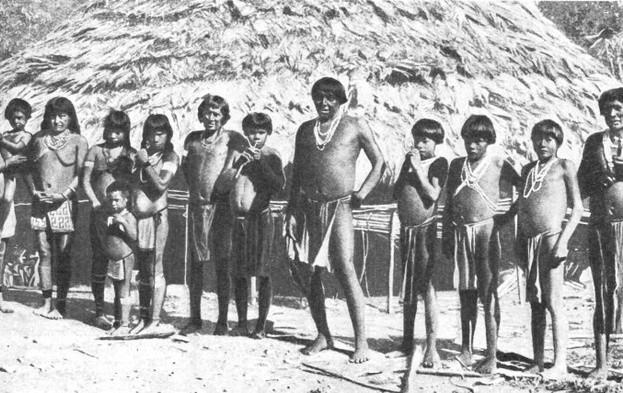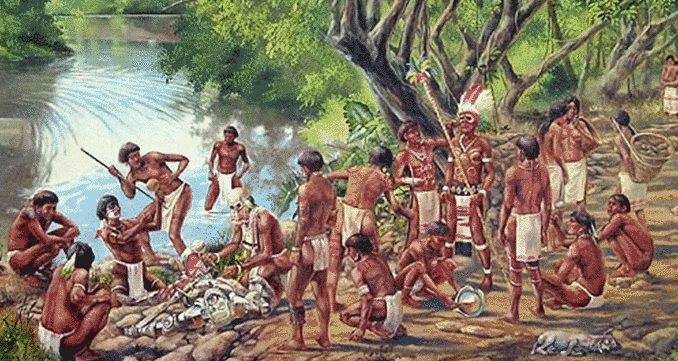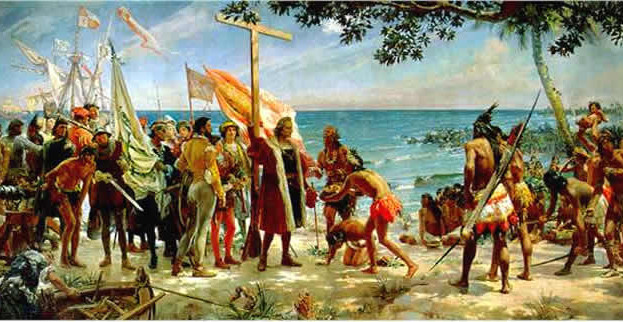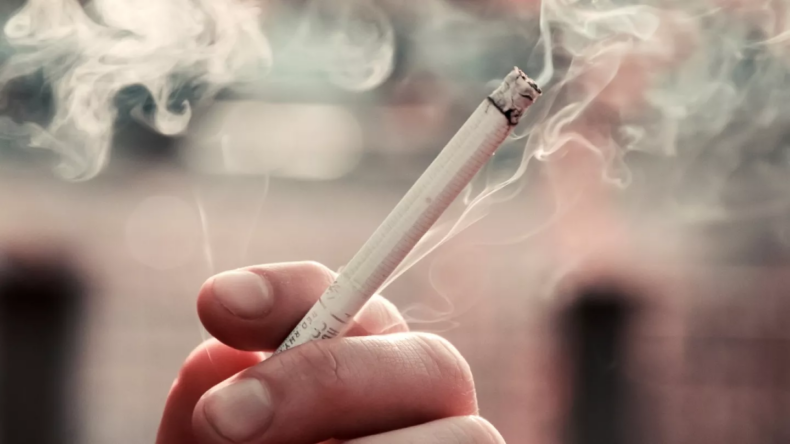Background: The Taino Arawak Culture
When we delve into the rich tapestry of history, it’s like unearthing hidden treasures, each shard and fragment telling a story. Among these is a particularly fascinating tale: the Taino Arawaks’ introduction of tobacco to Christopher Columbus. This exchange not only marked a significant cultural encounter but also laid the groundwork for a commodity that would deeply impact global history.
The Taino Arawaks, indigenous to the Caribbean islands, were a community rich in culture and traditions. Their way of life, harmoniously woven with nature, was both simplistic and profound. Understanding their culture is crucial to appreciating the significance of their encounter with Columbus. This introduction wasn’t merely about presenting a plant; it was a sharing of cultural heritage and knowledge, unbeknownst to them, would traverse oceans and centuries.

Columbus’s Historic Encounter with Tobacco
Picture this: the year 1492, a foreign vessel approaches the shores of the New World. Christopher Columbus, on a quest for Asia, stumbles upon an uncharted land. Little did he know that this ‘mistake’ would lead to one of the most notable cultural exchanges in history. Columbus and his crew were about to be introduced to something unfamiliar yet destined to become a global obsession – tobacco.
The first encounter with tobacco wasn’t just a fleeting moment; it was a monumental event, etching itself into the annals of history. This was the beginning of a saga that would see the humble tobacco leaf rise to prominence, influencing economies, societies, and cultures across the globe.
Pre-Columbian Americas: Lifestyle and Beliefs
To fully grasp the impact of this historical moment, we must transport ourselves to the Pre-Columbian Americas. This era, unbeknownst to the European world, was a cornucopia of diverse cultures, languages, and civilizations. Among them, the Taino Arawaks stood out for their unique lifestyle and beliefs.
Living harmoniously with nature, their beliefs were deeply intertwined with the environment. They held a profound respect for the land and its gifts, including tobacco, which they revered not just as a plant but as a sacred entity. Their lifestyle, a blend of agriculture, fishing, and hunting, was a testament to their adaptability and connection with their surroundings.
The Age of Exploration: Europe’s Quest for New Worlds
Meanwhile, Europe was in the throes of the Age of Exploration. This era was characterized by an insatiable curiosity and a relentless desire to discover new lands and trade routes. It was a time of daring voyages, driven by the promise of wealth, fame, and new horizons.
Christopher Columbus, an ambitious navigator, convinced of a westward route to Asia, found himself at the forefront of this quest. Little did he know that his journey would not lead to Asia but to a hitherto unknown continent, setting the stage for an unprecedented cultural rendezvous.
Who Were the Taino Arawaks?
Diving deeper into the story, we turn our focus to the Taino Arawaks themselves. These were a people whose history, often overshadowed by the events following Columbus’s arrival, is rich and deserving of recognition. The Taino Arawaks were not just inhabitants of the Caribbean islands; they were cultivators of a rich culture, artisans of a sophisticated society, and stewards of a profound spiritual worldview.
Their social structure, belief systems, and daily practices offer us a glimpse into a world that was both complex and enlightening. Understanding who they were is key to appreciating the gravity of their encounter with the European explorers.

Daily Life and Traditions
The daily life of the Taino Arawaks was a tapestry woven with customs, rituals, and a deep connection to the land. Their society, though simple in technology, was rich in tradition and communal living. From fishing and agriculture to art and storytelling, their everyday activities were not mere tasks but expressions of a culture deeply rooted in communal values and a harmonious relationship with nature.
Their traditions, passed down through generations, were more than just practices; they were the threads that held their community together, a testament to their resilience and spirit.
Spiritual Beliefs and Practices
The spiritual realm of the Taino Arawaks was a vivid tapestry, intricately woven with myths, deities, and rituals. Their belief system was not a mere aspect of their culture; it was its backbone, influencing every facet of their lives. They revered numerous deities, each embodying different elements of nature and life. Tobacco, within this spiritual mosaic, held a special place. It was not just a plant; it was a sacred medium, a bridge between the earthly and the divine.
Their rituals, often involving tobacco, were not just ceremonies; they were profound expressions of faith, healing, and communion with the spiritual world. Understanding these practices sheds light on why the introduction of tobacco to Columbus was more than a mere exchange of goods; it was an offering steeped in deep cultural and spiritual significance.
Tobacco in Taino Society
Tobacco held a revered status in Taino society, far beyond its later global perception as a recreational substance. For the Taino, tobacco was a sacred plant, integral to their spiritual practices and daily life. It was used in rituals, as medicine, and as a means of communication with the spiritual realm.
Understanding tobacco’s role in Taino society helps us appreciate the depth of what was being shared with Columbus. This wasn’t just the introduction of a new commodity; it was a profound sharing of cultural and spiritual heritage.
The Ritualistic and Medicinal Use of Tobacco
In the Taino community, the use of tobacco transcended mere consumption. It was deeply embedded in their ritualistic and medicinal practices. In ceremonies, tobacco smoke was believed to carry prayers to the spirits, and in medicine, it was used to heal a plethora of ailments.
This multifaceted use of tobacco underscores its importance in Taino culture. When Columbus encountered this plant, he was not just witnessing a new habit; he was being introduced to a profound aspect of Taino spirituality and healthcare.
Columbus’s First Glimpse of Tobacco
Imagine the moment when Columbus first witnessed the Taino Arawaks using tobacco. This encounter, documented in his diaries, was not just a footnote in his voyage; it was a pivotal moment in global history. Columbus’s glimpse of tobacco was the first step in a journey that would see this plant traverse oceans and cultures, eventually becoming a global phenomenon.
This moment of first contact with tobacco was more than a cultural exchange; it was the ignition of a global transformation that would unfold over the coming centuries.

The Quest for Asia and the Accidental Discovery
Columbus’s journey, initially aimed at finding a westward route to Asia, became one of the most significant accidental discoveries in history. This voyage, driven by a blend of ambition, curiosity, and the pursuit of wealth, unexpectedly led to the shores of the Americas.
This accidental discovery set the stage for the encounters and exchanges that would follow, including the introduction of tobacco to the European world. It highlights how history is often shaped by unexpected turns and serendipitous encounters.
First Contact: Europeans Meet the Taino
The first contact between Columbus and the Taino Arawaks was a momentous event, marking the beginning of a complex and often tragic interaction between the Old World and the New. This encounter, filled with curiosity and misunderstanding, was the starting point of a profound cultural exchange.
The meeting of these two worlds, vastly different in culture, beliefs, and technology, was not just a historical event; it was a moment that would reshape the course of human history.
Impressions and Observations: Columbus’s Diaries
Columbus’s diaries offer a window into his impressions and observations of the Taino people and their customs, including their use of tobacco. His writings, though colored by his perspective and biases, provide valuable insights into this historic encounter.
These diaries are not just historical documents; they are narratives that help us piece together the events, emotions, and perceptions of a world encountering itself in a way it had never done before.




